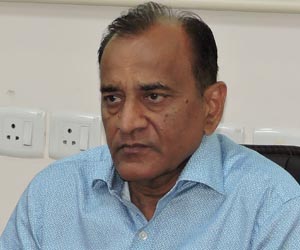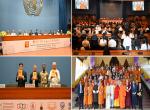The Bharatiya Janata Party (BJP) seems to be on a roll at the moment but we will soon know if the smile remains on March 11 when the results of five State Assembly elections are announced. For now it can bask in its success at the local body elections in Odisha and Maharashtra. Contrary to expectation and to its pleasant surprise, the party won more than 300 out of the 853 Zilla Parishad seats in Odisha. In 2012, it had secured just 36. Besides, the BJP ended up gaining control over eight of the 30 Zilla Parishads, reducing the pre-dominant Biju Janata Dal’s (BJD) hold from 28 Zilla Parishads to 16. The BJD, which had 651 seats in the 2012 election, had to contend with a vastly trimmed number at 450. All of this means that the BJP has roughly recorded a whopping 850 per cent increase in its electoral share in the Zilla Parishad elections in the State. There are two interesting aspects to the BJP’s performance. The first is that it has come in the rural backyard of the BJD — and of the Congress to a lesser extent. It’s evident that the BJP’s silent work in rural Odisha has fructified. The second is that the party has gained particularly well in the most backward Kalahandi-Bolangir-Koraput (KBK) region comprising eight backward districts (winning in four out of eight). This is bad news for Chief Minister Naveen Patnaik who heads the BJD Government there.
If the BJP surprised even itself in rural Odisha, it did very well in urban Maharashtra. The party gained control of as many as eight of the 10 municipal corporations that voted days ago. In the 227-member Brihanmumbai Municipal Corporation, it took on the Shiv Sena’s might and single-handedly ended up with 82 seats — just two short of the Shiv Sena’s number. Pune had been a stronghold of the Nationalist Congress Party (NCP) for close to a decade. The BJP has displaced it, winning enough to bring it close to the simple majority mark. The NCP finished second while the Congress and the Shiv Sena ended up as a poor third and fourth respectively. Barring Thane, where the Shiv Sena won (and of course Mumbai, where the same party finished first), the other municipal bodies in Maharashtra voted for the BJP.
The wins in the above two States were not a flash in the pan. A month earlier, the BJP had swept civic elections in Faridabad, Haryana, winning 30 out of the 40 seats on offer. Because its candidates had fought on the party symbol, the BJP hailed the result as a ‘referendum’ on the ‘good work’ being done by the Narendra Modi Government at the Centre. In Bhiwani, the BJP was victorious in 22 of the 31 seats. A little before the Faridabad triumph the party had swept the Chandigarh civic poll, winning 20 of the 26 seats on offer — one went to its ally, the Shiromani Akali Dal.
Ever since it came to power in the parliamentary elections in mid-May 2014, the BJP has been regularly registering wins across the country largely at the expense of the Congress Party and, at times by dislodging a regional party from its preeminent position. The two exceptions were Delhi and Bihar, where the party faced humiliating defeats in the Assembly elections at the hands of regional outfits. It lost Delhi to the Aam Aadmi Party because of wrong timing. Had the newly formed Modi Government at the Centre in 2014 taken an early call to hold the As-sembly election then, on the heels of the national victory, the result could have been very different. In Bihar the party committed mistakes just when it seemed to be cruising along pretty well in the run-up to the election — and that cost the BJP dear. While it does appear from the manner that it has so far conducted itself in the Uttar Pradesh campaign that the party has learnt its lessons, we will have to wait for the outcome.
Going back to the recent civic polls in Maharashtra, it seems to provides a good instance of how the BJP has, over the last two years or so, out-manoeuvred the regional Shiv Sena, still its partner in the State Government but now a junior one. Shiv Sena chief Uddhav Thackeray had called off the decades old alliance with the BJP for the last Assembly election, in the belief that the Shiv Sena, always the major partner in the alliance, would not just do fine by itself but also cut the BJP to size. Thackeray had, unfortunately for himself, not contended with the enormous goodwill that Narendra Modi enjoyed among the electorate of the State, nor had he taken into account the new voters who were not in the typical ‘Marathi manoos’ mould. The Assembly poll took place just months after the Modi-led BJP gained an absolute majority of its own in the Lok Sabha and had formed the Government at the Centre. While the BJP could not win a majority for itself in Maharashtra, it finished first, way ahead of the Shiv Sena — in fact, the BJP’s tally was nearly double that of the Shiv Sena. This definitively changed the political dynamicsin the State, compelling Shiv Senato assume a junior partner’s position. At the Centre too, only a small clutch of its nominees was inducted into the Union Ministry, and that too not in high-profile positions.
In the Haryana Assembly election too, it decimated the regional Indian National Lok Dal, besides handing over a stinging defeat to the other major political party, the Congress. In recent months, the BJP has made remarkable gains in the North-East too, forming Governments in Arunachal Pradesh (with the Chief Minister and his group crossing over to the party) and Assam (where the BJP defeated an incumbent Congress regime). And, while it was gaining fresh ground across the country, the party was also securely holding on to States it already had — for instance, Madhya Pradesh, Rajasthan and Chhattisgarh. Now, in the five State Assemblies, whose composition will be known on March 11, the BJP hopes to win four (one, Goa, it is looking to retain power, and in the other three it’s confident of defeating the incumbent regimes). The problem area, from accounts so far, is Punjab, where the BJP is a junior partner in a coalition with the Shiromani Akali Dal. If the BJP is victorious in four of the five States, it will be sufficient cause for it to celebrate.
So why is it that the BJP has been going from strength to strength while its rivals are falling by the wayside? What explains the continued popularity of Prime Minister Modi (so much so that his charisma is being banked upon by his State party units that do not even project a chief ministerial candidate)? The easy answer would be — and one that many analysts readily offer — is the ‘TINA’ (There Is No Alternative) factor. This is not just a lazy response but also a shallow one, TINA did not exist in the 2014 election; it certainly did not in the various State Assembly and local body elections. It would be more accurate to say that one of the causes is the ‘TINCA’ (There Is No Credible Alternative) factor. The absence of a credible alternative is not the BJP’s doing but a failure of the rival parties. Nothing has stopped the Congress from projecting a strong and credible leadership. If its senior leadership, now led virtually by Rahul Gandhi, has not been able to win the confidence of the electorate, time and again, the party — the country’s oldest, with the most hallowed past — must introspect.
It’s not that the Congress and others who are opposed to the BJP and Prime Minister Modi have not tried; they have attacked relentlessly but with the wrong weapons, and counter-punched on the wrong issues and with amateurish effort. Most of these have boomeranged, leaving the BJP not just un-dented but stronger than before. Recall the hullabaloo when a few churches in some parts of the country were vandalized in the early months of the Modi Government? The Left-liberal-secular brigade had linked the incidents to the arrival of a ‘communal regime’ under the umbrella-ship of the Rashtriya Swayamsevak Sangh (RSS). The RSS and its affiliates, including the BJP, had gone red in the face denying their involvement, but the secular mind was made up — it always is. Subsequent probes exposed the reality, which was that the acts had nothing to do with politics, and even less with the BJP or the Sangh parivar.
Then came a spate of attacks in various States against some poor Dalit families. Again the Modi Government was held responsible, although law and order is a State subject and some of the States where the incidents happened were ruled by non-BJP parties. No RSS/BJP hand has been established in those crimes to date, although the investigations were carried out by agencies under the jurisdiction of State governments that rival the BJP. But perhaps the most high-profile action of lampooning the Modi Government and seeking to ridicule it before the international community came with what is popularly referred to as ‘Award Wapsi’.
In the early days of 2016, a bunch of Sahitya Akademi authors were struck by a sudden burst of conscience against ‘growing levels of intolerance’ under the Modi dispensation, which led them to announce the return of their awards to the Academy. As evidence of such ‘intolerance’, the eminent writers quoted the lynching of a Dadri resident from a minority community on suspicion that beef had been cooked in his house. They also referred to the murder of a couple of rationalists. Again, these happened in States not ruled by the BJP, and the Governments in those States ought to have done the lawful thing — investigate, hunt down the suspects and ensure they were punished. But the tragic instances became fodder for the Opposition to directly target Prime Minister Modi and his regime.
This façade, ironically but not surprisingly, only boosted the Prime Minister’s image among the millions of Indians — the result is evident in the series of electoral victories. The question is: How can opposition parties be so daft-headed as to not understand the consequence of their mis-adventurism? Why is it that they insist on continuing with a campaign that has lost credibility — for instance, the “suit-boot-ki-sarkar” jibe at the Modi Government? The last two Union Budgets, with a decided emphasis on agriculture and social/rural sectors all but buried the calumny. The answer to this riddle is simple enough: Modi’s rivals have failed to appreciate that the 2014 verdict was to change the governance template. The Old Normal was not going to be the New Normal ever again. Political correctness as defined by the Left-liberals had been rejected by the people. And the Modi Government is only living by the promises it had made to the people, and these are the promises on which it had been voted to power.
Here, a quick comparison with conditions in the United States of America would be in order. Donald Trump’s arrival as the new President has had analysts working overtime to make sense of the transition. Walter Russell Mead, a noted academic in international relations, has delved into various ‘isms’ to make sense of the development. Writing in Foreign Affairs, he expands on “Jeffersonian”, “Jacksonian”, “Hamiltonian” and “Wilsonian” streams of thought, and eventually concluded that some way must be found to “stop the liberal order’s erosion”. He is admittedly referring to not just the US but the world in general, and yet his core concern remains a US led by President Trump. In India, we do not have all these many ‘isms’ to deal with — though ‘fascism’ is a much flung word at Prime Minister Modi by his critics who know little of the term. Perhaps there is just one ‘ism’ that is relevant, and that is Nehruvianism. India’s new order has no place for it, or at least for many of its features.
This is not necessarily because there is something inherently wrong with the idea — though there is enough of that to warrant the discarding of the concept. It’s because the idea has outlived its time. The new world order is different from what it was when India gained independence. Indeed, it is vastly different than what it was just two decades ago. Noble intents of non-alignment, for instance, are redundant, and strategic partnerships with different nations not always similarly inclined, is the in thing. Besides, national interest and not fanciful ideology has become the driving force in international relations. Additionally, within India, the idea of secularism has got to be understood in ways different from what the Western template tells us. What was derided as jingoism until now, has become a source of pride not to be shied from. Thus, Make in India is not an empty slogan; it’s a reflection of a nation’s resolve to aggressively push for a stature among the global community. To claim proudly to be a Hindu, or a Muslim, or whatever, is not to be seen as asserting one’s identity with a view to confront but to merely establish a given truth. The new India may be idea-driven, even ideology-driven, but it’s certainly not willing to be driven by jaded ones.
The boon and bane of democracies is that you have experts by the dozen who claim to know more than you do — at times they do know; often the voters know better — and seek to pass off their opinions as that representing the enlightened citizens. India has been no exception. Since for historical reasons, such experts in India have emerged from the Left-liberal society, they are the most rattled lot today. They just cannot make sense of the entrenchment of the Modi persona and its continuing appeal. Worse, for them, they cannot come to terms with the reality. Additionally, they are now confronted with the ‘other’ intelligentsia — of the Right kind which is eager and willing to give as much as it gets, and more. The clash of ideas that we see is not so much that — it’s more a clash of templates. In the Kanhaiya Kumar/Umar Khalid cases, the battle is between those who see ‘nationalism’ as uncompromising and those who hold the right of dissent as fundamental enough to even seek the disintegration of the nation. If the former is heard more than before, it’s merely a sign of the changed template in place.
For those who believe in playing safe, in being rooted to old templates, here is wisdom from Martin Luther King Jr: “There comes a time when one must take a position that is neither safe, nor politic, nor popular, but he must take it because conscience tells him it is right.”
(The writer is Opinion Editor, The Pioneer, senior political commentator and public affairs analyst)

.jpg)









Post new comment